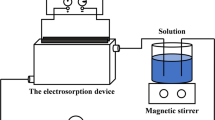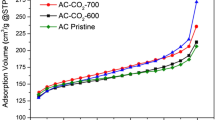Abstract
The Manganese oxide/active carbon fiber (MO/ACF) was prepared and its electrosorptive properties of Cd(II) in aqueous solution were investigated. The structure of MO/ACF was characterized with transmission electron microscopy, X-ray diffraction, and Fourier transform infrared spectroscopy. Furthermore, the Cd(II) electrosorptive properties of MO/ACF electrodes with different bias potentials, ionic strengths, and loaded amount of manganese oxides were measured and the electrosorption isotherm and kinetics were investigated. The Cd(II) electrosorptive capacity of MO/ACF was 6 times higher than that of pure ACF. The optimal adsorptive bias voltage was 1.5 V and the optimal electrolyte concentration of NaCl was 0.1 mol/L. The adsorption isotherm was agreed well with the Freundlich adsorption model and its maximum electrosorption capacity was 14.88 mg/g by Langmuir model. The higher adsorptive capacity of MO/ACF than that of pure ACF is attributed to higher capacitance and more adsorptive sites of MO/ACF.











Similar content being viewed by others
References
Abhishek K, Kumar RR, Shalini S, Srivastava MM (2013) Nanocellulose fibers for biosorption of cadmium, nickel, and lead ions from aqueous solution. Clean Technol Environ Policy 16:385–393
Bãn A, Schãfer A, Wendt H (1998) Fundamentals of electrosorption on activated carbon for wastewater treatment for industrial effluents. J Appl Electrochem 28:227–236
Chang LM, Duan XY, Liu W (2011) Preparation and electrosorption desalination performance of activated carbon electrode with Titania. Desalination 270:285–290
Chen CH, Jun CH (2013) Electrosorptive removal of copper ions from wastewater by using ordered mesoporous carbon electrodes. Chem Eng J 221:469–475
Chen W, Fan Z, Gu L, Bao X, Wang C (2010) Enhanced capacitance of manganese oxide via confinement inside carbon nanotubes. Chem Commun 46:3905–3907
Chi HZ, Tian S, Hu SH, Qin HY, Xi JH (2014) Direct growth of MnO2 on carbon fiber cloth for electrochemical capacitor. J Alloy Compd 587:354–360
Choonsoo K, Jaehan L, Seoni K, Jeyong Y (2013) TiO2 sol–gel spray method for carbon electrode fabrication to enhance desalination efficiency of capacitive deionization. Desalination. doi:10.1016/j.desal.2013.07.016
Gabelich CJ, Tran T, Suffet IHM (2002) Electrosorption of inorganic salts from aqueous solution using carbon aerogels. Environ Sci Technol 36:3010–3019
Gao Y, Pan L, Li H, Zhang Y, Zhang Z, Chen Y, Sun Z (2009) Electrosorption behavior of cations with carbon nanotubes and carbon nanofibers composite film electrodes. Thin Solid Films 517:1616–1619
Hajar M, Mohsen J (2013) Comparative and competitive adsorption of cadmium, copper, nickel, and lead ions by Iranian natural zeolite. Clean Technol Environ Policy 15:303–316
Huang CC, Su YJ (2010) Removal of copper ions from wastewater by adsorption/electrosorption on modified activated carbon cloths. J Hazad Mater 175:477–483
Kai K, Yoshida Y, Kageyama H (2008) Room-temperature synthesis of manganese oxide monosheets. J Am Chem Soc 130(47):15938–15943
Kardam A, Raj KR, Srivastava S, Srivastava MM (2013) Nanocellulose fibers for biosorption of cadmium, nickel, and lead ions from aqueous solution. Clean Technol Environ Policy. doi:10.1007/s10098-013-0634-2
Kim YJ, Choi JH (2010) Improvement of desalination efficiency in capacitive deionization using a carbon electrode coated with an ion-exchange polymer. Water Res 44:990–996
Li HB, Gao Y, Pan LK, Zhang YP, Chen YW, Sun Z (2008) Electrosorptive desalination by carbon nanotubes and nanofibres electrodes and ion-exchange membranes. Water Res 42(20):4923–4928
Li HB, Zou LN, Pan LK (2010) Novel graphene-like electrodes for capacitive deionization. Environ Sci Technol 44:8692–8697
Li LX, Zou LD, Song HH, Morris G (2009) Ordered mesoporous carbons synthesized by a modified sol–gel process for electrosorptive removal of sodium chloride. Carbon 47(3):775–781
Liu YX, Yan JM, Yuan DX, Li QL, Wu XY (2013) The study of lead removal from aqueous solution using an electrochemical method with a stainless steel net electrode coated with single wall carbon nanotubes. Chem Eng J 218:81–88
Pan L, Wang X, Gao Y, Zhang Y, Chen Y, Sun Z (2009) Electrosorption of anions with carbon nanotube and nanofibre composite film electrodes. Desalination 244:139–143
Peng L, Yuan LL, Yang XF, Zhou SJ, Huang X (2013) Coupling ion-exchangers with inexpensive activated carbon fiber electrodes to enhance the performance of capacitive deionization cells for domestic wastewater desalination. Water Res 47:2523–2530
Ravi J (2012) Providing safe drinking water: a challenge for humanity. Clean Technol Environ Policy 14:1–4
Tay M , Myint Z, Dutta J (2012) Fabrication of zinc oxide nanorods modified activated carbon cloth electrode for desalination of brackish water using capacitive deionization approach. Desalination 305(1):24–30
Villar I, Roldan S, Ruiz V, Granda M, Blanco C, MeneÌndez R, SantamariÌa R (2010) Capacitive deionization of NaCl Solutions with modified activated carbon electrodes. Energy Fuels 24:3329–3333
Wang L (2010) Electric Adsorption removal of heavy metal ions. Xi’an: Xi’an University of Architecture and Technology
Xia H, Lai M, Lu L (2010) Nanoflaky MnO2/carbon nanotube nanocomposites as anode materials for lithium-ion batteries. J Mater Chem 20:6896–6902
Yang J, Zou LD, Song HH, Hao ZP (2011) Development of novel MnO2/nanoporous carbon composite electrodes in capacitive deionization technology. Desalination 276:199–206
Zheng HJ, Tang FQ, Jia YJ, Wang LZ, Chen YC, Lim M, Zhang L, Lu GQ (2009) Layer-by-layer assembly and electrochemical properties of sandwiched film of manganese oxide nanosheet and carbon nanotube. Carbon 47(6):1534–1542
Zou L, Morris G, Qi D (2008a) Using activated carbon electrode in electrosorptive deionization of brackish water. Desalination 225:329–340
Zou LD, Song HH, Li LX, Morris G (2008b) Using mesoporous carbon electrodes for water desalination. Water Res 42(8–9):2340–2348
Acknowledgments
This project was supported by the Postdoctoral Science Foundation of Central South University. For the financial support we are grateful to the Changsha City Science and Technology Project (K1301103-11), National Natural Science Foundation of China (No. 21007014), Natural Science Foundation of Hunan Province (13JJ04068).
Author information
Authors and Affiliations
Corresponding authors
Rights and permissions
About this article
Cite this article
Chen, Y., Peng, L., Zeng, Q. et al. Removal of trace Cd(II) from water with the manganese oxides/ACF composite electrode. Clean Techn Environ Policy 17, 49–57 (2015). https://doi.org/10.1007/s10098-014-0756-1
Received:
Accepted:
Published:
Issue Date:
DOI: https://doi.org/10.1007/s10098-014-0756-1




